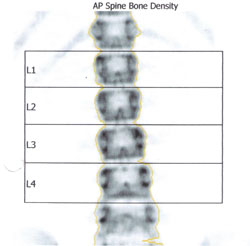Both HIV and antiretroviral therapy (ART) can cause damage to bones, leading to reductions in mineral content. When these reductions are severe, they can lead to bone weakness and increased fracture risk. A special x-ray machine called a DEXA scanner can measure bone mineral density (BMD) and compare it to standard values obtained from healthy people, resulting in something called a “Z-score,” which reflects how well or how poorly the BMD result compares to the average value. When the BMD Z-score is < -2, the patient is considered to have low bone density, a condition known as osteopenia.

A bone scan result as the doctor sees it |
Thai investigators supported by TREAT Asia have conducted the first study of bone health among adolescents with HIV in Asia.1 A total of 101 HIV-positive adolescents (with a median age of 14 years) who had been on ART for an average of seven years underwent DEXA scans.
Their median CD4 cell count was 646 cells/mm3, and 90 percent had undetectable HIV viral loads (at <50 copies/mL). When compared to DEXA standards developed from a separate survey of healthy Thai adolescents, 24 percent of those with HIV were found to have BMD Z-scores of < -2. In addition, 25 percent of adolescents with HIV had low levels of vitamin D, a key nutrient for promoting bone health. Factors associated with a greater likelihood of having a low BMD Z-score included low height for age (relative to other Thai adolescents; 6.2 times higher odds) and having had advanced HIV disease before starting ART (i.e., World Health Organization Stage 4; 3.7 times higher odds).
Studies such as this one point to the consequences that older children and adolescents are now facing because of delays in starting treatment for their HIV infection. Earlier treatment can prevent growth delays and protect against the direct effects of long-term HIV infection on bones and other organs of the body. By prioritizing earlier diagnosis and referrals to care, we can help ensure that infants and children with HIV will benefit from the lessons of the past.
1 Puthanakit T, Saksawad R, Bunupuradah T, Wittawatmongkol O, Chuanjaroen T, Ubolyam S, Chaiwatanarat T, Nakavachara P, Maleesatharn A, Chokephaibulkit K. Prevalence and Risk Factors of Low Bone Mineral Density Among Perinatally HIV-Infected Thai Adolescents Receiving Antiretroviral Therapy. Journal of Acquired Immune Deficiency Syndromes. 2012 Dec 1;61(4):477-83.